Season 1, Episode 2: “SEEING THINGS”
RECAP
“She articulated a personal vision. Vision is meaning. Meaning is historical.”
1995
Upon finding the bird trap from the Fontenot house at the end of episode one, Rust and Marty continue to ponder the significance of the murderer’s totem. The two then meet with Dora Lange’s mother, where Rust takes note of certain items in the house: an angel statue, an empty medical bottle, and a very curious picture of Dora as a child surrounded by masked men on horses. Her mother and Dora’s friend also mention a Church that Dora had mentioned joining prior to her disappearance. In the car afterward, Marty asks Rust if his mother is still alive, to which he replies “maybe”. Rust also explains about his daughter’s death to Marty, and the dissolution of his marriage that came soon after.
That night, Marty gets drunk with the other cops at a bar called The Elks and calls up his mistress for a late night rendezvous—Lisa Tragnetti (Alexandra Daddario). Afterward, Marty warns her about the fact that the Erath killer may be responsible for more murders and asks her to stay at home, to which she replies “but I can’t meet a nice man at home”. That same night, Rust experiences further visual hallucinations vis-à-vis his synesthesia while driving down the highway. He later meets with the hooker from episode one, who supplies him with further barbiturates. She also offers him sex, though Rust declines. Instead, he prods her for further information about Dora and the hooker offers up the name of “The Ranch”—a rural and isolated brothel for young runaways.
The next morning, Rust makes veiled references to Marty’s scent—prompting a violent confrontation wherein Rust threatens to break Marty’s hands for further aggression. In order to find the hidden brothel, the two question a pair of local mechanics reticent to offer the location—prompting Rust to use more violent methods to find the location.
The detectives then drive deep into the woods to find the ranch harboring young runaways turned prostitutes. The madam of this “bunny ranch” bickers with the two, and they also meet Beth—a young runaway staying on the ranch. Before leaving, Marty gives Beth a wad of cash—prompting a “that a downpayment?” from Rust—while the latter departs with Dora’s diary. Inside, he finds the murdered woman’s scribbled ramblings, specifically: talk of “The Yellow King”, Carcosa, and angels. Rust also contemplates the chance that the killer was feeding Dora drugs and slowly upping the dosage without her knowing. They also find an advertisement for a Church folded up in the diary—resolving to seek it out next.
At Maggie’s parents house, Marty argues with his father-in-law about the current state of world affairs while Maggie similarly argues with her mother. At home, the bickering continues amongst the couple. When Marty announces dinner to the girls in their room, he notices that the girls have posed their dolls in a clear sexual fashion.
At the office, Rust insults the newly appointed members of the occult task force and is reprimanded by the Major for his disobedience. Marty pleads for more time, and the Major relents. The episode concludes with the detectives stumbling upon the demolished remains of Dorothy’s church. But before entering, Rust’s synesthesia gives way to another vision—a peculiar circling of crows that outlines the mark of the Yellow King across the sky. And as the episode ends, the detectives uncover a painting upon the Church’s wall depicting a blindfolded woman posed in the exact same position as Dora Lange was found murdered against the tree.
2012
Marty’s interview mostly concerns further prodding from Papania and Gilbough as to Cohle’s methods and interviews within the investigation, along with thinly veiled references as to his needing to “get his head right”—cheat on his wife—for the good of the family. They also question him about the Task Force, to which Marty admits he likewise detested from the start.
Meanwhile, Cohle’s interview offers a great deal more information as to his backstory: his three-year-marriage, the death of his daughter, and his subsequent career transfer from robbery to narcotics, where he unloaded a bullet into a junkie shooting up his infant daughter with crystal meth. This resulted in his transfer to undercover, where in the aftermath of a deadly shootout and extended drug use, Rust landed in a psychiatric hospital in Lubbock, Texas. He is further questioned about his hallucinations, and though he admits to not experiencing them anymore, he does explain that back then: “Most of the time I was convinced, yeah, shit, I’d lost it…there were other times, I thought I was mainlining the secret truth of the universe”.
———————————————————————————————————————
REVIEW
(Spoilers All)
Perhaps more than any other episode, “Seeing Things” offers the most comprehensive glimpse into Rust’s backstory and most linear explanation for his current psychological state. Rust’s tragic life history—starting with his absent mother, progressing to the death of his daughter, to the dissolution of his marriage, to his interment at a psychiatric hospital—all allow for the first true insight into how this man came to view to the view the world in such dark, cynical terms.
The ’95 storyline opens in interesting juxtaposition with their meeting Dora’s mother, and the sad state of affairs left in this very broken home. Rust’s keen eye spots the mother’s empty prescription pill bottles, Pieta statue, and most suspiciously—the framed picture of Dora as a little girl surrounded by masked men on horses.
Meanwhile, the episode also helps sketch an interesting portrait of the psychology that composes the normally “straight” detective of Marty Hart. While episode one sets Marty up as the straight man to Rust’s idiosyncratic personality, Marty is revealed to hold a moral compass far different from Rust—one who justifies cheating on his wife and reprimanding his wife as she makes dinner in the name of the job. (In another case of reading far too into things but interesting in hindsight, Marty is at a bar called Elks—Elks being an animal equipped with antlers not unlike those crowning Dora Lange’s skull—before he drunkenly calls his mistress.)
However, after their sexual rendezvous, Lisa’s very loaded line to Marty in responding that she “can’t meet a nice man at home” works on multiple levels to excellent effect—both answering Marty’s question and addressing his infidelity as being not “good guy” in a single swift line. This aspect of Marty’s very ambiguous morality is highlighted further by the introduction of the “ranch”—a deplorable runaway for young girls turned to prostitutes of which the murdered Dora Lange was a former resident. Despite the horrendous nurture of the setting, The Ranch remains amongst one of the best demonstrations of the show’s superb production design—a faraway shot of the ranch limned by bright lights far deep in the woods standing as one of the show’s best shots. There’s an eerie atmospheric quality that saturates the ranch’s setting—imbuing a feeling of reality so far removed from most fictional portrayals of prostitution that is utilized to memorable effect this otherwise short sequence.
More to the point, the madam calls out Marty’s hypocritical nature when confronting such sexuality (and while he is sober with a badge on), when stating: “Why is it you add business to the mix boys like you can’t stand the thought. I’ll tell you why: it’s ‘cus suddenly you don’t own I the way you thought you did”. As revealed in later episodes, it becomes quickly clear that Marty does view women with a possessive sense of nature that continually leads to violence: he beats up Rust after the affair with Maggie, he beats up the boys arrested with Audrey, he beats up the next man having an affair with Lisa instead of him. And of course, Rust’s “is that a down payment” line ends being disturbingly accurate when Marty and Beth meet again after the latter has come of age.
Moreover, the episode highlights what a façade Marty’s familial life serves as the classical, masculine male detective. Much to Marty’s chagrin, his father-in-law reminiscences on his era in stating: “People said ma’am and sir. Families stayed together”. This classic view of the American lifestyle comes to odds both against Marty’s current predilection for cheating on his wife, and the fact that he and Maggie do indeed separate following the affair with Rust. It’s also interesting that Marty more or less echoes his father-in-law’s statements during his interview in stating: “There was a time when men didn’t air their bullshit to the world. You know, just wasn’t part of their job.” Of course, the irony in this line being delivered is the fact that Marty is doing exactly that with the detectives in his current interview.
These interviews serve an interesting narrative function in both allowing the audience to understand the methodology of a detective and of the show’s storytelling at large—a story within a story as invisibly and expertly woven by Pizzolatto’s decision to juxtapose these parallel timeline against each other. Marty explains the job to Papania and Gilbough as: “ You know the job, you’re looking for narrative…interrogate witnesses…parcel evidence…establish a timeline…build a story…day after day…” which also perfectly describes the actual narrative and structural foundation of the show itself. The audience is looking for the larger narrative as left unanswered by the clues of the case, Marty and Rust are serving as witnesses, the audience is parceling pieces of evidences established vis-à-vis clues like the bird trap, a timeline is being established, etc…
But again, it is Rust’s insights into his backstory that are most important for this episode. The former detective admits that he believes “it’s not good for people to be around me” when discussing the collapse of his marriage in the wake of his daughter’s death. A sentiment that helps explain a lot of Rust’s curt replies to those in the ’95 timeline. Nonetheless, he also expresses the interesting line: “I know who I am, after all these years, there’s a victory in that”. Though Rust does appear to be all-too-confident in his image of himself and his thoughts on his world, especially as solidified in this line, his seeing “the void” in the finale upends this broken version of himself that has so drastically warped his identity. As will also become relevant in the finale, he explains to Papina and Gilbough as to his daughter’s death that she: “went straight into a coma, then somewhere in the blackness, she slipped off into another, deeper kind. Isn’t that a beautiful way to go out?” Rust glimpses this blackness, then the “deeper kind” when confronted with the void while battling Errol, that offers a striking visual as to this sentiment that’s interesting to keep in mind.
This episode also gives further examples as to the former detective’s exceptional skills as an investigator. As Marty explains in his interview, “Rust had as sharp an eye for weakness as I’ve ever seen”. This is most memorably demonstrated first on Marty, when Rust begins making passive-aggressive comments in the locker room in the morning after the former’s late night affair with Lisa. Though Marty attempts to again use physical violence against Rust, the latter is able to calmly explain: “you got some self-loathin’ to do this mornin’, that’s fine, but it aint’ worth losin’ your hands over”, as he slowly twists his hands over Marty’s with clear expertise. Later, when searching for the ranch, Rust’s able to ascertain its exact location by exerting incredible athleticism and physical control over the two mechanics holding back information when he’s able to immediately sense that the two are withholding details because of their badges.
Lastly, Rust’s visions are given a bit further explanation. He explains that he could always tell “what was real and what wasn’t”, but it becomes quickly obvious that sometimes this reality is often a blurred line. The crows that swirl to create the mark of the Yellow King perhaps serving as the best demonstration, as they signal that Rust is close to finding another important clue in the case through the image of the bound woman painted upon the demolished wall of the Church.
Though this episode is even more character heavy than most episodes, a few other very important clues of the case begin to emerge. The masked men on horses standing over a young Dora offers the first clue toward an image that will become integral moving forward. Somewhat related, this episode also gives its first glimpse into Audrey’s psychological troubles that will become a more prominent problem later on. Before Marty walks in to the girls’ room to announce dinner, their dialogue can be heard as: “You don’t have a mommy or daddy anymore. Yours died in an accident—
How?
A car accident.”
This one plot thread remains the show’s biggest red herring and disappointingly unanswered question, as this dialogue reflects the death of Rust’s daughter before Marty stumbles upon the image of the dolls posed in the same sexual fashion as the men on horses above a little girl seen in Dora Lange’s house. This is both dialogue and image far, far too important symbolic that sadly remains a mystery. Nonetheless, the detectives do find Dora’s diary within the ranch that offers perhaps their biggest clues as to giving the killer an identity—The Yellow King—along with the first mention of Carcosa. The diary also offers the advertisement for the Church that concludes the episode—a painting of a bound woman posed in eerily similar fashion as the two found Dora Lange.
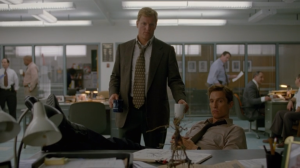
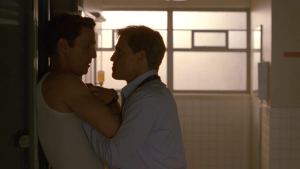
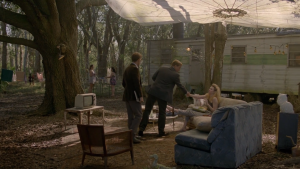
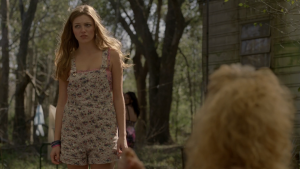
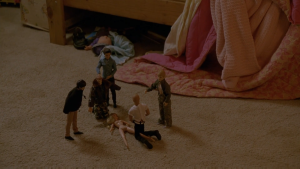
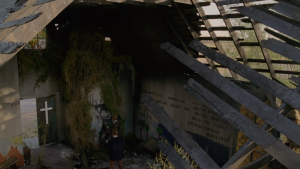
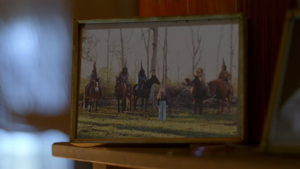
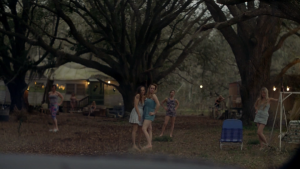

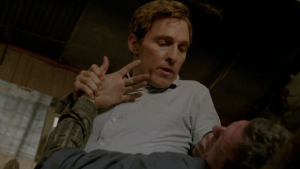
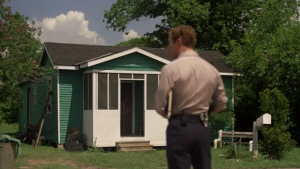
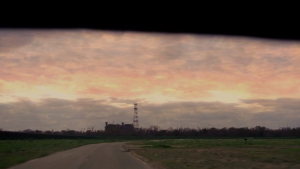
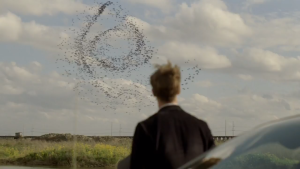

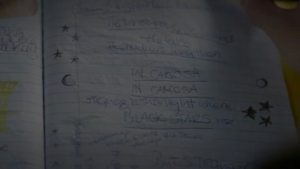

I will watch it and judge it on its merits as a Cop Show with hopefully a great storyline and cast……….but its True Detective in name only for now………the first series was a masterpiece in method acting by McConaughey and Harrelson, and had a great multi-layered dark storyline……..(and whilst it was no The Wire) was pretty much the best cop show since The Shield, Justified and the Line Of Fire